Menus
- Custom for all !
- This Kawasaki hides its game well. Under its air of custom for young license, the Vulcan S is actually a fake roadster with a sparkling character and formidable versatility !
- Presentation
- Motor
- Part-cycle
- In the saddle
- In the city
- Motorway and expressways
- On departmental
- Comfort and duo
- Braking
- Consumption
- Accessories and ergonomics
- Conclusion
- The assayer’s equipment
Custom for all !
This Kawasaki hides its game well. Under its air of custom for young license, the Vulcan S is actually a fake roadster with a sparkling character and formidable versatility !
The Japanese never do anything by chance. At Kawasaki for example, the introduction of the Vulcan S is justified by a study showing that the customs segment has recently increased by 13%. Another key figure, without the very strong growth in registrations of small engines (for a custom … so from 650 to 850 cm3), customs would have fallen by 11%. In short, there is demand for a small custom capable of seducing the greatest number and whatever the brand. It is also no coincidence that Harley-Davidson launched its Street 750 last year despite a troubling price proximity to its bestseller, the Iron 883. The Street 750 has moreover a little the same target than that of the Kawasaki Vulcan S: young people, first-time buyers with A license, girls, urbanites … In short, a machine accessible to as many bikers as possible, especially if they have a tight budget, but the recipe chosen by Akashi’s firm differs radically from that of Milwaukee !
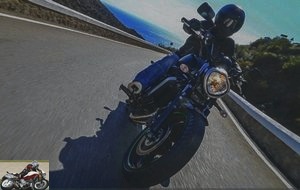
Presentation
A little marketing pride, Kawasaki tells us that its EN 650 (its internal catalog reference) is the brand’s first custom to be marketed worldwide under the “Vulcan” label. Indeed, for obscure reasons of commercial law, several importers (including France) had to be satisfied with the badge “VN” much less glamorous. As for the “S”, it implies that Kawasaki has added a zest of sport in its custom. Besides, green men describe their machine as a Power Cruiser Light. An entire program.
On the design side, this translates into some modern touches such as a triangular front headlight, an LED rear light unit, an exhaust housed under the engine with an aggressive look (at least on the right side), an overall treatment of the predominantly black surfaces sprinkled with spikes brushed aluminum and finally aggressive rims enhanced with a border. Colors, the 2015 vintages delivered to dealerships will be available in black, white or Metallic Royal Purple, a sort of very dark glittery purple already seen on some emblematic models of the brand including the ZRX 1100, a large long-haired roadster dating from the era. Jurassic.
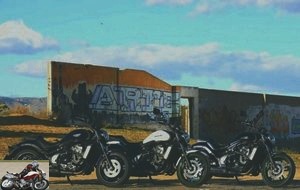
Motor
The engine base is well known since it is the vertical twin of 649 cm3 already equipping the ER-6 and Versys 650. Logically, the block has been reworked to offer a look and a character closer to the guns in force in the customs. Externally, Kawasaki added a chrome cylinder head cover to it while the cylinder head itself mimics the fins of an air-cooled engine. Inside, the changes are much deeper with new camshafts and intake ducts with a significantly reduced diameter to improve filling at low and medium speeds. The new exhaust has also been developed to improve this characteristic. Finally, the flywheel of the crankshaft sees its weight increase by about 30%. On the performance side, this translates into 61 horsepower at 7,000 rpm and 63 Nm of torque at 6,600 rpm. For comparison the Versys 650 makes 69 horsepower and the ER-6 72 but much higher in the revs. Incidentally, Kawasaki announces a reduction in consumption of 5%. Not bad in these times of crisis … A kit for A2 license holders will also be available in dealerships.
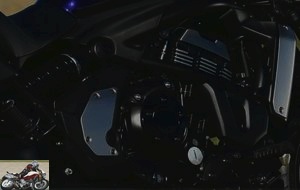
Part-cycle
For its mini power cruiser, Kawasaki has chosen an open perimeter steel frame that is anchored directly to the twin, which plays an active role in the rigidity of the whole. The oscillating arm, also in steel, is made of elliptical tubes. For the suspensions, it’s basic with a non-adjustable telescopic fork of 41 mm in diameter offering 130 mm of travel and at the rear an offset shock absorber mounted on a rod and adjustable on 7 preload steps. Beginner target requires, the ergonomics have been particularly worked with a high saddle of only 705 mm and especially several kits and accessories to adapt as well to the basketball players as to the short-legged garden gnomes (see the accessories and ergonomics section for More details). The tires are also entitled to a little custom treatment with 18 inches at the front in 120/70 (and still 17 at the rear in 160/60), all mounted on specific rims. The final transmission is entrusted to a chain rather than a belt or cardan. If Kawasaki admits that maintenance is more restrictive, the Japanese firm justifies this choice by a gain in weight and a lower level of friction, which results in a higher power transmitted to the rear wheel. Despite this virtual weight gain against the competition, the standard Vulcan S is given for 225 kg all full (ABS: 228 kg) against 204 kg for an ER-6N and 214 kg for the Versys 650.
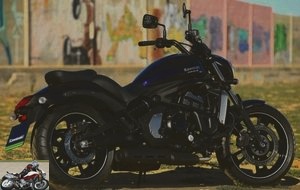
In the saddle
To get some warmth during this winter period, Kawasaki invited us to Spain and more exactly to Almeria. Despite this southern destination, the morning temperature flirts with 5 ° C. While the little Kawa is heating up on her side stand, let’s do a regular inspection of the beauty. The finish is generally of a very good level with quality paint, a very discreet electrical harness, polished frame welds and stainless steel screws for the engine block. The radiator frame is very well done, the plastic covers covering the frame at knee level a little less … The remark is also valid for the covers coiled on either side of the rear fender and the assembly. bib-brake light-indicators but the metal / plastic ratio is well below the union minimum for this type of machine.
Stepping over the Vulcan S takes formality. With my meter seventy, I find myself with the legs largely bent, well helped by a very thin saddle at the junction of the tank and an engine with compact crankcases. The ladies will have room … Camped on the ultra-low saddle, the hands come to rest naturally on a handlebars equipped with clutch levers and adjustable brakes. The left stalk is even entitled to a warning command. The mirrors are ideally placed and the footrests are just a tad far away for my size.
The instrument panel is relatively complete with an analog tachometer overlooking a liquid crystal display showing the time, speed and the amount of fuel remaining in the tank. A separate window can display the choice of the total mileage, two trips, the average or instantaneous consumption as well as the remaining range.

In the city
Here, the Vulcan S is clearly in its element. The extra weight compared to an ER-6N is not handicapping, in particular thanks to a much lower center of gravity. And despite the “feet forward” position, the overall behavior is similar to that of a roadster. Here, there is no tipping effect in bends negotiated at low speed, nor any offset between front and rear axles, as is the case with certain models equipped with a 21-inch bicycle wheel at the bow or with a flange. XXL at the stern. Other good news, the exhaust, discreet and well behaved, keeps its calories for itself at the red light rather than giving it to your calves. We enjoy the general stability by moving at a walk and the setting on the angle is as soft as it is progressive. As for the vertical twin, it loses a little in character but gains in flexibility and pleasure in this new configuration. In sixth, we can resume on a trickle of gas around 2500 revs (50 km / h) and even 2000 revs on lower gears. But the real useful range begins at 3000 revs, when you can open the throttle grip wide without the twin starting to knock. The soft clutch and the uneventful gearbox complete an almost idyllic picture. Indeed, the steering angle, although very correct, would have deserved a few more degrees to be perfect in the U-turns and the high handlebars are at the same level as that of the oil-fired displacers, limiting the rise of queues in traffic jams..
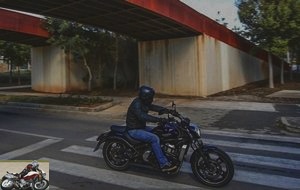
Motorway and expressways
The hands in the air and feet forward position is not conducive to high averages on long journeys and even less to peak speeds. The meter block deflects the wind from the torso to the level of the plexus but everything else is exposed to wind and weather. Morality, we naturally stall on 130 km / h (6,000 rpm in 6th gear) or even a small 110 with the wind from the front (5,200 laps). At these speeds, close to the maximum torque value, the twin has resources and does not need to drop a gear to offer times worthy of the name. On a closed road (or the straight line of the Almeria circuit) the Vulcan S can climb without forcing up to 160 km / h then barely a little to reach its maximum speed of around 190 km / h. Futile but informative…
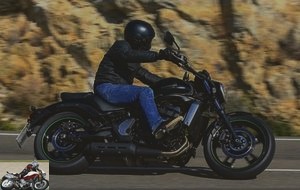
On departmental
Usually, rough roads are a nightmare on a custom’s handlebars due to poor ground clearance. Fortunately, that of the Vulcan S would be almost like that of a roadster. The footrests rub relatively late and even then the little Power Cruiser still has quite a bit of headroom. If necessary, we can add a few notches on the preload of the rear shock absorbers and especially take out the inner leg to be able to tilt the machine even more … before attacking the screws of the footrest plates and, for the most bleeding, the protection side of the exhaust. In short, the Vulcan S readily lends itself to fun driving. Besides this decent ground clearance, the Kawa displays rigorous handling as long as the asphalt remains smooth. The front and rear suspensions work together and the hydraulics contain the mass transfers in reasonable proportions. The front axle, agile but lightly loaded, is not a model of feedback, but the long wheelbase, low center of gravity and Dunlop Sportmax tires always inspire confidence. And the small twin, which is brave despite its calm power, adds a zest of fun to the whole. After 5,000 rpm, it climbs with gusto towards the red zone up to the maximum power value (7,000 rpm) with vigorous acceleration punctuated by the hoarse rattle emanating from the air box. He even keeps a little stretch, agreeing to climb 500 laps higher before seeing his power regulate. Be careful, do not imagine yourself carving out croupiers to a Z1000 either … The front axle tends to stiffen when you grip the brakes on the corner and on degraded roads, better to drive more calmly. We quickly reach the end of the shock absorber deflections and the too fast hydraulic expansion quickly catapults your buttocks into the air.
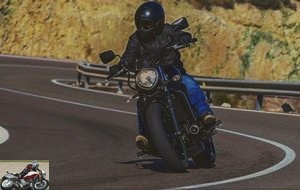
Comfort and duo
Despite a definition of suspensions a little firmer than the guns in force among customs, the Vulcan S remains classified in the category of so-called comfortable machines while coping with the limits imposed by the genre. The fuse here is once again the rear suspension which only debates on 80 mm against 120 at the front. This is sufficient in the majority of cases but the passages of Spanish speed bumps (it is true in XXL format) in an urban environment required scrupulously respect the speed limits to preserve the integrity of my foundation. For the passenger, the seat is soft as it should be but the Sissi-bar option is more than recommended since there is no grab handle. And long journeys will test your sandbag’s sense of self-sacrifice with high-placed, fairly set back footrests.
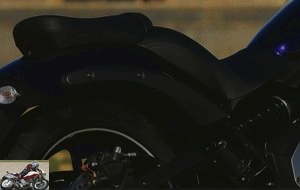
Braking
At the front, there is a simple 300 mm brake disc clamped by a floating caliper with two superimposed pistons. Behind, it is a 250 mm disc and a single piston caliper that do the job. An ABS version is also available in the catalog (+ 400 €). In use, the brake disc has been shown to be very efficient with a good attack if you have a little grip and very convincing power compared to the performance of the whole. On the sublime junction between Lucainena de Las Torres and Nijar, composed almost entirely of turns over more than 25 km, the Vulcan S ended up showing signs of weakness with a slight guard at the lever but preserved power. The front disc is still tinged blue under the effort but it is by far what we do best in this segment. Note that the large and long brake pedal controlling the rear offers a very precise dosage of power. In sporty driving, the ABS of our test versions has been triggered a few times – mainly at the rear – but its entry into action is always very smooth and hardly affects the braking distances..
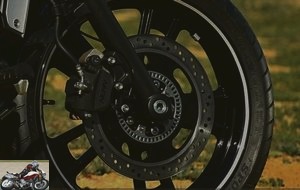
Consumption
During our test, spread over two days, the on-board computer indicated values varying between 4 and 5 liters under normal use and being able to climb up to 7 liters in very nervous mode. The tank with a capacity of 14 liters therefore augurs well for a total autonomy varying between 200 and more than 350 km depending on your mood….
Accessories and ergonomics
To adapt to all sizes, the Vulcan S offers two kits, one for very large, the other for toddlers, which will be billed around € 300. You can either move the footrests forward or backward by 25 mm and opt for a closer (+ 53 mm) or distant (N.C.) saddle. As a last resort, you can also opt for a handlebar bringing the handles closer to 44 mm. Note that each element (handlebars, saddle …) will be available separately to order to lower costs or to fine tune a position. Finally, note that the adjustment of the footrests requires the purchase of a specific selector link. The Greens have also planned a host of accessories to personalize the Vulcan S. These include a gear indicator engaged and a 12V socket which are housed on each side of the instrument cluster. And to transform the Vulcan S into a mini GT, Kawasaki offers not one but two windshields (large and medium), each removable without tools and lockable with a key, as well as removable leather side cases. Only problem, once dismantled, they reveal very little discreet side supports. The option catalog also has two optional luggage racks (one with a Sissi-bar) using the same system as the windshield. In the purely cosmetic department (non-exhaustive list), we can mention chrome handlebars, clutch housings (chrome or black), or even silencer protections … Price and availability were not available at the time of our test.
Conclusion
The Vulcan S is a relevant machine if it is not consensual. Rather than entering into direct confrontation with a Harley Street 750 and its legendary badge, it plays the card of originality with a look and an engine character quirky and especially a behavior placing it halfway between a classic custom and a roadster . Easy to handle, excellent braking machine and more versatile than all its competitors, it also offers a modularity hitherto unknown in this niche, with a small additional financial effort. Fortunately, its price is rather well placed with a base price set at € 6,899 and € 7,299 in the ABS version. One unknown remains: the impact that the sound of the vertical twin will have on customers, a hundred places from the “potatoe, potatoe” of a V2, typical architecture of customs…
Strong points
- Road holding and braking
- Ease of handling
- Modular ergonomics
- Quirky look and character
- Mechanical approval
Weak points
- Chain transmission
- Some finishing details
- Sound of vertical twin ?
The assayer’s equipment
- Shark Raw Helmet
- Forma Slam Dry Shoes
- Gloves Furygan James D3O
- Esquad Triptor Trousers
- Furygan Clark jacket
Kawasaki Vulcan S 650 technical sheet
Related articles
-
Kawasaki Z H2 Supercharged motorcycle test
200 hp, 14 mkg at 8,500 rpm, 239 kg all full, 17,099 € Put some salt ! Fifteen days of driving with the Kawasaki Z H2? I say it bluntly, it takes less to…
-
2012 Kawasaki ER-6f motorcycle test
Swiss army knife first price While the ER-6n has been a historic bestseller in the Kawasaki lineup since its debut in 2006, its streamlined “f” version…
-
Evolution or revolution of the ER6-f with the in-line twin of 649 cm3, 68 horsepower for 193 kilos A more sporty look but, paradoxically, a gain in…
-
Ninja Apprentice On paper, we imagine that the Kawasaki Ninja 250 R, with only 33 horsepower, will only appeal to the young drivers. After a week of…
-
Roadster with Sugomi sauce or decarenated sports car A2 licenses have the choice between large bridles, sometimes very badly bridled, and smaller ones,…
-
4 cylinders in line, 948 cm3, 111 hp at 8,500 rpm, 10 m / kg at 6,500 rpm, 215 kilos, from € 11,999 A skillfully modified Z 900 or the worthy heir to the…
-
Kawasaki VN 1700 Voyager Custom ABS review
Kawa makes the clone …. With her very sleek lowered silhouette and plethora of equipment, this slanted-eyed American is largely inspired by the Harley…
-
40 horses at 11,500 rpm 25.7 Nm, 175 kilos with full tank, two colors, € 5,799 An easy and sparkling little trail: what if life on a motorcycle was as…
-
4 cylinders in line, compressor, 998 cm3, 210 hp at 11,000 rpm, 137.3 Nm at 9,500 rpm, 260 kilos, € 21,999 Kawasaki reinvents the super-fast and…
-
The Z ReviZitee From the top of its eleven Z’an, the Z rolls mechanics and adopts a new look which is scary . For this new model, the manufacturer…
Are the prices of new motorcycles exploding or am I dreaming of?
"From 21 150 euro" … It’s prohibitive, really. To put a price so high as to reach the full option price of BMW and thus develop an almost exclusive image, it is a risky strategy. The sales volumes are not comparable to the GS (mentioned here since it is the front reference) to address this pricing dimension. The discount on the second-hand market is quite simply staggering (-7500 euros in 1 year according to Argus consulted at a dealer) In addition, the new features on the machines are found in many manufacturers for 2018: The screen TFT, Full Led lights (directional for some) cannot by themselves justify this increase. In addition, the TFT screen everyone is getting started for 2018. Regarding the weight, the 10kG less promised by Triumph are to be considered only for the top-of-the-range versions, automatically equipped with the Arrow pot (+ 265kg all full done for the 2016 version). Otherwise, it only scratches a few KG which will unfortunately always be too much to claim to offer comfort of use, loaded motorcycle. Having said that, it is a very good machine. I separated from the Tiger 1200 XCA (bought in 2017) and clearly, despite all the "comfort and practical" qualities it possesses, it remains a high-legged road, with treacherous looks. I was on my 3rd Triumph, and I’m still a big lover of the Hinkley brand .. but that’s too much. It makes me suffer .. 😢. She now has to reach a maximum weight of 240 kg TPF, and there, only there, she will be a game-changer..
>> A former owner of the fully equipped XCA version: opinion after 13000Km over 8 months, including a loaded road trip <<
haaaa, a return from the sprint, I would like that!
@ Aristoto & Vesperal: sorry, I messed up when I confused the price of the XCa (€ 21,150) with that of the XRt at € 19,950. All my confusing and it is rectified. The range of 1200 XR now starts at 15 950 € with the XR, there is indeed a small increase but the endowment is increasing.
Philippe
@ Philippe, alias Phil G: thank you especially to you and your team for these varied and quality photos !
The writing of the articles is pleasant and always stylish, which is far from the case on many sites!
Well, welcome, thank you also to the Le Repaire team who, in the back office, do a lot of work so that, as a rule, you are the first to be informed..
That was the sequence #mercimercimerci
Philippe
Raah … thank you Triumph, saved, a trail 800 with 15,000 balls was missing in the motorcycling landscape …
Come on, humor what … at least a Himalayan 410 fits my budget and meets my expectations of simplicity, so everything is fine !
Those who have a white beard like me will surely remember that old advertising slogan for the Citroen Ax "not expensive enough, my son …". Note that on a motorbike in recent years, the recipe taken at 1st degree works really well!
Renault Clio the ad! Woh put … that’s it, the neurons are going out …